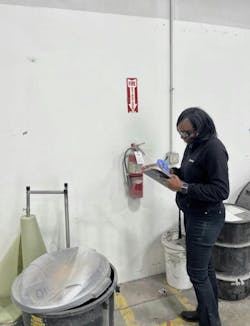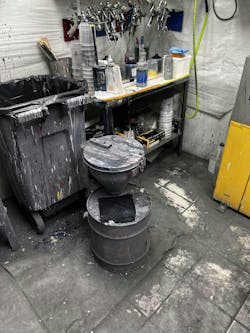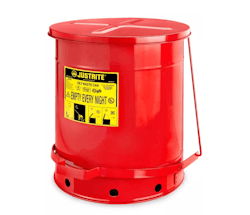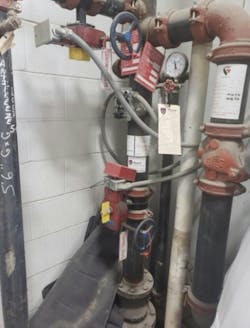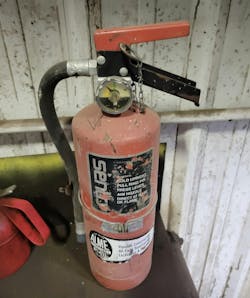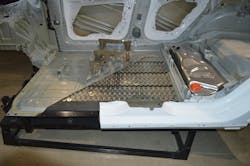Where flammable paint and fuels have the potential to meet the ignition sources of a welder or a grinder, the collision repair shop can be a dangerous environment. But there are some steps you can take to minimize your shop's risk.
I have worked in the automotive aftermarket in one way or another for over 28 years. During that time, I’ve known of multiple shop fires, especially at a time when all work lights used hot incandescent or halogen bulbs that could easily ignite spilled gasoline. But about 12 years ago, I had the misfortune of experiencing one. At the time, I was a sales and technical representative for a paint, body, and equipment distributor. As I was taking inventory in the mixing room and updating the color library on the computer at the shop of one of our customers, one of the technicians in the adjacent building yelled for me to come quickly. As I turned to the walk door connecting the two buildings, I was shocked to see flames shooting up from the GMT 800-platform Chevy pickup on the frame rack several feet high. As he frantically removed the fire extinguisher from the bracket, a column of black smoke rose to the ceiling and rapidly descended to the floor. The little 10-lb. extinguisher had no visible effect on beating back the flames; it was time to evacuate and call 911.
The shop owner had been welding in new rocker panels as part of a rust repair on the pickup. The owner had put down the MIG welding torch and stepped outside to see the latest specials on the tool truck that had just shown up. What he didn’t realize was there was some noise/vibration/harshness-reducing foam that had ignited from welding and had begun smoldering and then flared up in his absence. The sole technician who’d remained in the shop and yelled for my help was working on a car with his back turned to the scene 30 feet away, and by the time he saw the flames, the truck was engulfed. It was a total loss, and other non-driveable works in process were also totaled from smoke damage. The damage throughout the post-frame shop was mostly smoke-related, although the fire burned through the sheet metal ceiling to the bottom chords of the trusses. Thankfully, there were no injuries, and after four to six weeks, the shop was back in business.
Identifying Common Problem Areas
GMG EnviroSafe has been helping body shops avoid fires and stay compliant with environmental and safety regulations since 1989. In talking with Kevin Dwyer, product manager about some common violations his company representatives see on site visits, many of the violations may seem like common sense. At the same time, they are also frequent enough that this article can serve as a quick reminder of areas of concern that should be addressed.
The paint department is where most violations occur, Dwyer says. Beginning with the basics, having a paint mixing room with explosion-proof wiring is essential.
“I’d say probably 80 percent of the shops do, but I do run into shops that don’t have one. You need it, because that’s where you’re supposed to be storing all your flammables, such as paint and thinners.”
It should also have a 4” sill at the bottom of the mixing room door to be able to contain all the flammable liquid stored in the room so it doesn’t end up in a drain.
A metal trash can with a metal lid is the only acceptable receptacle for solid waste, as if a fire starts in a plastic trash can, the fire will consume the can and spread.
“If it’s a metal trash can, the fire will stay contained to the can and then it can be put out by putting the lid on top of it, choking any oxygen in there,” he says.
Masking materials with uncured primer and paint material overspray, as well as disposable paint cups that still contain solvent-borne paint residue, are the biggest sources of flammable material, Dwyer says.
“You’re supposed to drain that residue into the waste drum, but a lot don’t do that; they just chuck it. That can be an issue if it’s solvent paint waste.”
Drums of waste paint and virgin thinner require a ground cable and clamp to be attached to them, a quick step that is often overlooked at the time they are switched. Funnels used for waste paint should have a self-closing lid, and if they’re used with polyethylene drums, they should also include a flame arrestor.
Another violation noted by GMG EnviroSafe’s inspectors is missing faceplates for electrical outlets in older shops. Electrical extension cords must have intact ground terminals, can’t be frayed, and cannot be “daisy-chained” (interconnected).
Compressed-gas Cylinder Storage
“One of the most dangerous things is compressed gas cylinders,” Dwyer says, noting spare cylinders must be stored upright and secured with a chain or some other method.
“When we go to the shops, one of the first things we check – and this violation is a big fine from OSHA – when they’re in storage, oxygen and acetylene bottles need to be separated by at least 20 feet. When they’re on a cart and being used for work, they’re fine. They need to be stored away from high-traffic areas and exits as well.”
Oily rags must be disposed of — or stored — in a metal container, such as a flammable-materials metal step can, to avoid a source of spontaneous combustion.
Fire Suppression
Shops must also have some kind of fire suppression in the paint booth, whether it’s a wet system through the building’s sprinkler system or a dry system with tanks outside the booth. A dry system must be serviced every six months, and sprinkler heads must remain unobstructed. And don’t forget “No Smoking” signs on the paint booth and in the mixing room.
All fire extinguishers must be solidly mounted with signage above them, have ready access, be fully charged (indicator arrow showing in the green), and serviced each year.
“Once a month, someone in-house is supposed to be checking every single extinguisher. There's a tag on the extinguishers from the company that serviced them. And on the back of the tag, there are 12 boxes, one for each month of the year to initial.”
Although fires in neglected paint booth exhaust stacks are possible, Dwyer says the shops they visit are good about changing their filters.
“We give them changeout logs so they can initial and date every time they change the booth filter.”
EV Safety Training
A growing area of expertise for the company is in EV safety training, Dwyer says.
“That is a huge fire risk as well because once those batteries start burning, they don't go out. The fire department needs to put water on them for hours.”
To minimize the fire risk, Dwyer recommends that shops use an intake process just for EVs.
“That’s an issue, because shops don’t realize that. They’re kind of just bringing them in like they do with normal cars. But when you get an EV, you need to identify it and put a placard on it saying it’s an electric vehicle or use some kind of communication system so that everyone in the shop knows this is an EV.”
Before the vehicle is brought into the shop, the battery pack should be assessed for its integrity.
“You could use an infrared camera to look for hotspots. You need to take an initial reading, and then wait 10 or 15 minutes and come back to take another one just to make sure the battery is not heating up. If it’s heating up, there’s a chance it could be going into thermal runaway.”
As Dwyer notes, that means damage to one cell of hundreds or thousands (depending on the design of the battery pack) ignites the damaged cell, and then ignition and fire continue to spread in adjacent cells in a sort -of domino effect.“If you bring that into the shop and the car goes into thermal runaway, there’s a good chance the shop’s going to burn down. Someone’s going to get hurt. So you really need a good intake process to make sure [thermal runaway] is not happening.”
The company will tailor a written plan for EV safety, including personal protective equipment (PPE), and training for technicians and administrative staff.
“We try to make it so it’s not as technical for the admin people, to make it easy on them.”
The company has also been doing “EV Wednesdays” on LinkedIn for a little over a year, including topics such as job hazard assessments, hazard communication programs, and PPE requirements. Although some fear working on EVs, Dwyer said much of the fear is unfounded.
“There is a lot of hype around EVs, but the cars are built to be safe. If you just do what you’re supposed to, you’ll be fine. If you wear your PPE and you follow the repair process, there's nothing to it, you'll be fine. Once you deenergize the vehicle, it's just a regular vehicle. There's just so much hype behind electricity it freaks people out. I often talk to techs in the shop, who say, ‘I'm never gonna work on those. But, it's pretty simple. It's about a 20-minute de-energization process.”
Site Plan
A site plan, which serves as an emergency evacuation plan, is sometimes required by the fire marshal. But the company creates one for each of its customers, with copies of it posted at all exit locations and in each department plus the break room or area. It’s also available on a mobile device.
“I’ve seen it happen where the shop manager will be outside with the fire department, and they can look at his phone for the site plan.”
Offering Peace-of-mind
“There are a lot of different ways with safety to keep the government off your back. But if something happens, you don’t need to worry about it. You can just give us a call, and we’ll come take care of it. We manage compliance for the shops. Shop owners have a lot that keeps them up at night, so that’s something we want to try to give them peace of mind so they don’t have to worry about so much.”
The company offers assistance with compliance for OSHA, EPA, and where applicable, the DOT.
“We’re boots on the ground; we’re in your shop working with you. Most of these other companies are just doing online training. We do offer online training, too, but a lot of the older technicians don’t like using computers. We do bilingual training in-person and online. We cover every state, and we are in Canada as well.”
About the Author
Jay Sicht
Editor-in-Chief, FenderBender and ABRN
Jay Sicht is editor-in-chief of FenderBender and ABRN. He has worked in the automotive aftermarket for more than 29 years, including in a number of sales and technical support roles in paint/parts distribution and service/repair. He has a bachelor's degree in journalism from the University of Central Missouri with a minor in aviation, and as a writer and editor, he has covered all segments of the automotive aftermarket for more than 20 of those years, including formerly serving as editor-in-chief of Motor Age and Aftermarket Business World. Connect with him on LinkedIn.
Don't miss Jay's next article or podcast. Sign up for FenderBender Today's Collision Repair News and ABRN eNews here.

